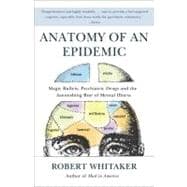
Note: Supplemental materials are not guaranteed with Rental or Used book purchases.
Purchase Benefits
What is included with this book?
| Foreword | p. ix |
| The Epidemic | |
| A Modern Plague | p. 3 |
| Anecdotal Thoughts | p. 12 |
| The Science of Psychiatric Drugs | |
| The Roots of an Epidemic | p. 39 |
| Psychiatry's Magic Bullets | p. 47 |
| The Hunt for Chemical Imbalances | p. 67 |
| Outcomes | |
| A Paradox Revealed | p. 89 |
| The Benzo Trap | p. 126 |
| An Episodic Illness Turns Chronic | p. 148 |
| The Bipolar Boom | p. 172 |
| An Epidemic Explained | p. 205 |
| The Epidemic Spreads to Children | p. 216 |
| Suffer the Children | p. 247 |
| Explication of a Delusion | |
| The Rise of an Ideology | p. 263 |
| The Story That was … and Wasn't Told | p. 283 |
| Tallying Up the Profits | p. 313 |
| Solutions | |
| Blueprints for Reform | p. 331 |
| Epilogue | p. 361 |
| Notes | p. 363 |
| Acknowledgments | p. 395 |
| Index | p. 397 |
| Table of Contents provided by Ingram. All Rights Reserved. |
The New copy of this book will include any supplemental materials advertised. Please check the title of the book to determine if it should include any access cards, study guides, lab manuals, CDs, etc.
The Used, Rental and eBook copies of this book are not guaranteed to include any supplemental materials. Typically, only the book itself is included. This is true even if the title states it includes any access cards, study guides, lab manuals, CDs, etc.